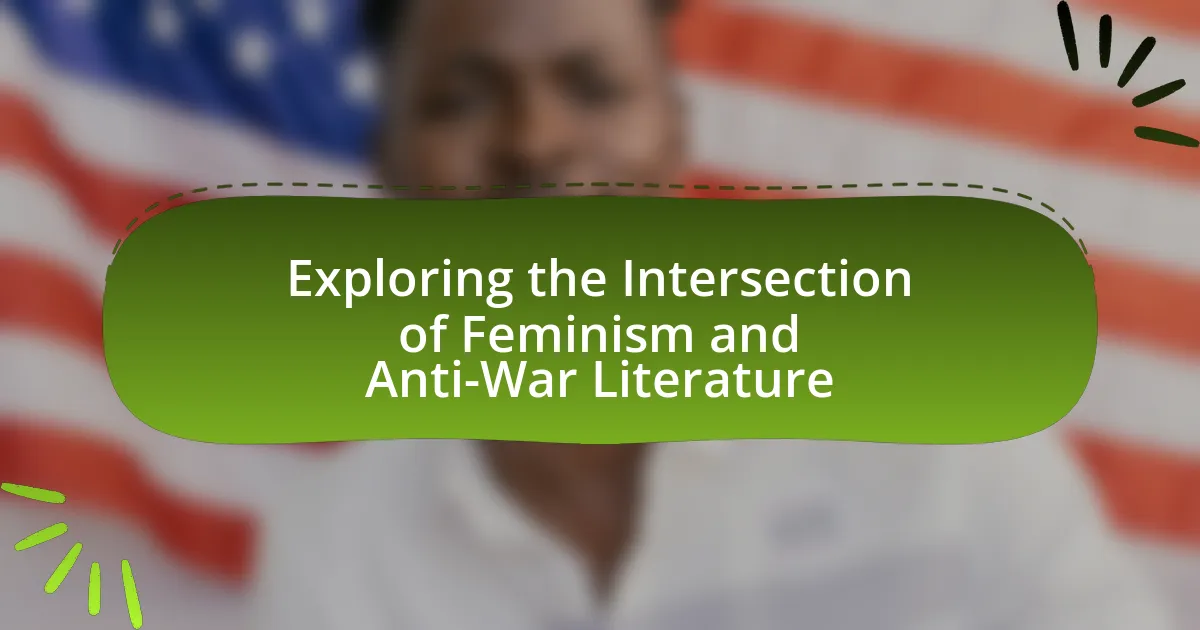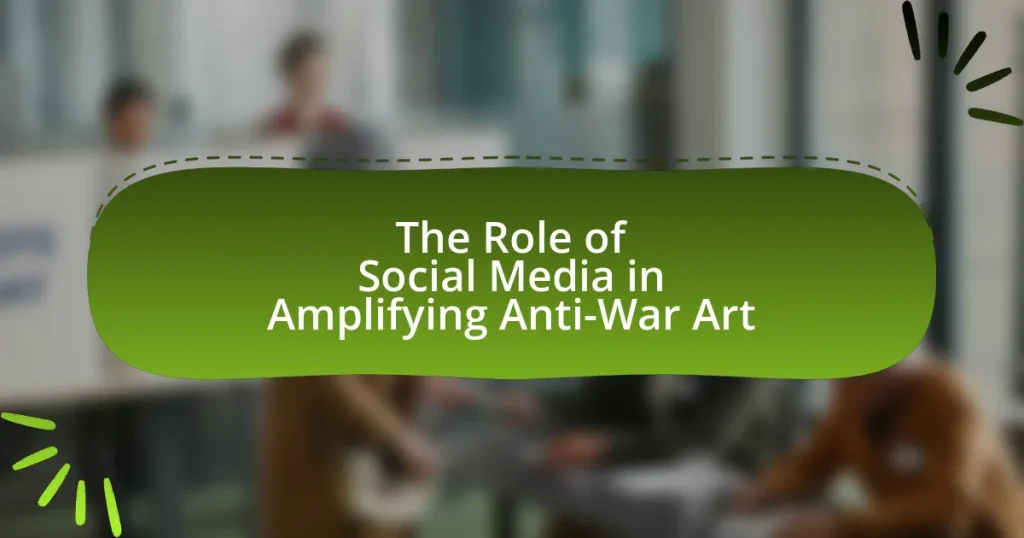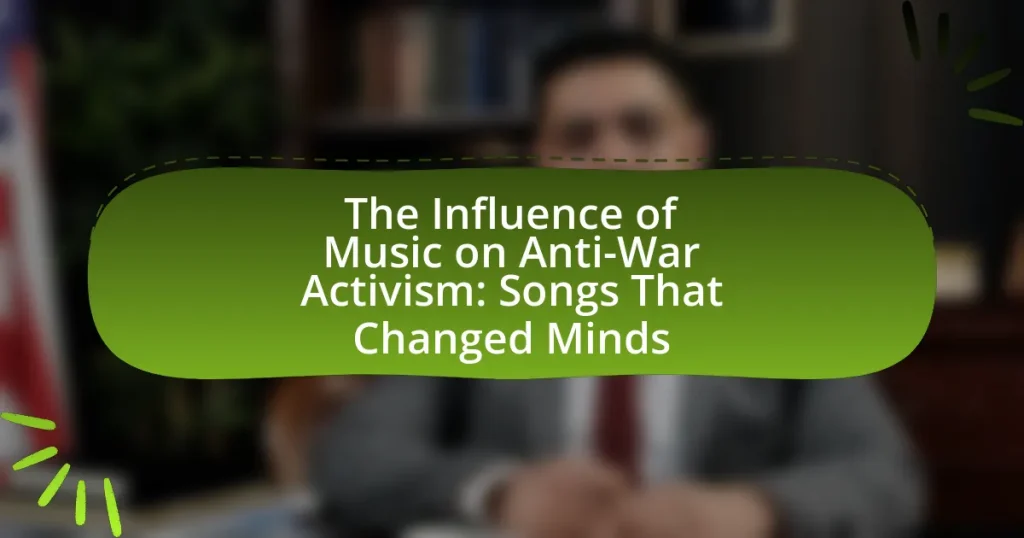The article explores the intersection of feminism and anti-war literature, highlighting their shared critique of patriarchal structures and the impact of militarism on women and society. It discusses how feminist anti-war literature emphasizes the unique experiences of women in conflict, showcasing authors like Virginia Woolf and Adrienne Rich, and examines historical contexts that have shaped this relationship, including major wars and feminist movements. Key themes such as gendered violence, advocacy for peace, and the role of feminist activists in anti-war movements are analyzed, along with the challenges faced by feminist voices within these discourses. The article underscores the importance of integrating feminist perspectives to foster a more inclusive understanding of war and its societal implications.
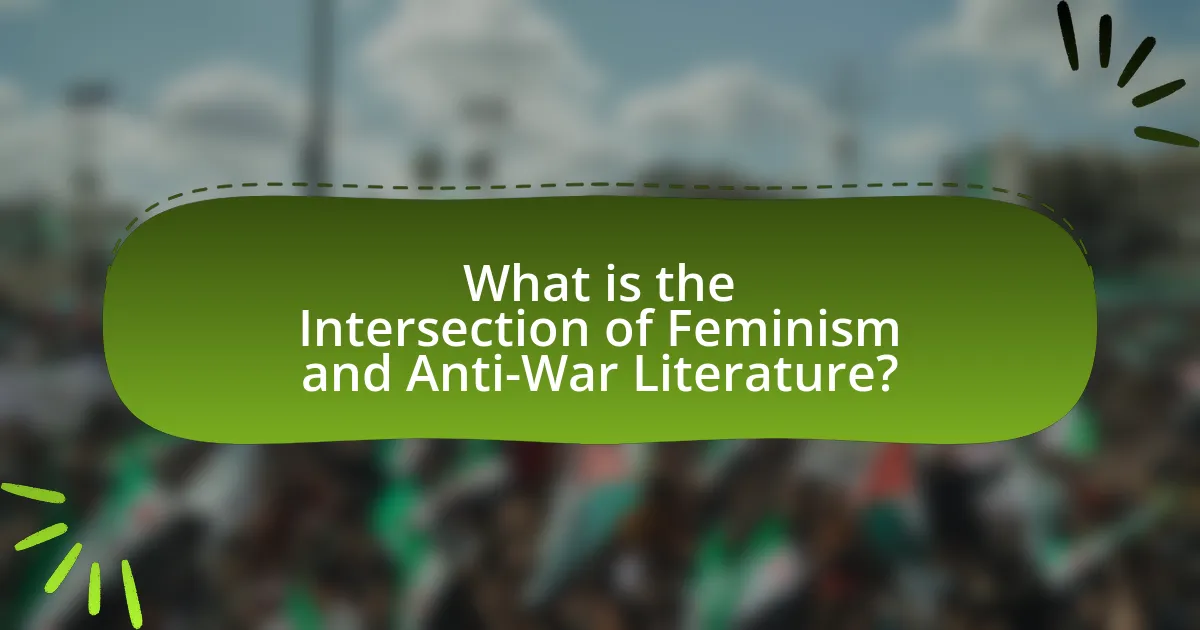
What is the Intersection of Feminism and Anti-War Literature?
The intersection of feminism and anti-war literature lies in their shared critique of patriarchal structures and the impact of militarism on women and society. Feminist anti-war literature often highlights how war exacerbates gender inequalities, portraying women’s experiences and voices in conflict situations. For example, works by authors like Virginia Woolf and Adrienne Rich emphasize the emotional and social toll of war on women, advocating for peace and gender equality. This intersection is further evidenced by the feminist anti-war movements, such as the Women’s Peace Party founded in 1915, which sought to address both the consequences of war and the systemic oppression of women.
How do Feminism and Anti-War Literature relate to each other?
Feminism and anti-war literature are interconnected through their shared critique of patriarchal structures and the impact of militarism on marginalized groups. Feminist perspectives often highlight how war disproportionately affects women, exacerbating gender inequalities and violence. For instance, during conflicts, women face increased risks of sexual violence and displacement, as documented in reports by organizations like the United Nations. Anti-war literature, such as works by authors like Virginia Woolf and Adrienne Rich, emphasizes the moral and ethical implications of war, advocating for peace and social justice, which aligns with feminist goals of equality and human rights. This intersection underscores the importance of addressing both gender and militarism in discussions about peace and conflict.
What historical contexts have shaped the relationship between Feminism and Anti-War Literature?
The relationship between Feminism and Anti-War Literature has been shaped by historical contexts such as the World Wars, the Vietnam War, and the feminist movements of the 20th century. During World War I and World War II, women took on roles traditionally held by men, leading to a reevaluation of gender roles and the impact of war on society. The Vietnam War era saw a surge in feminist activism, where women writers like Adrienne Rich and Alice Walker critiqued militarism and its effects on women, linking anti-war sentiments with feminist ideology. Additionally, the rise of second-wave feminism in the 1960s and 1970s emphasized the interconnectedness of gender, war, and peace, further solidifying the relationship between these two movements. These contexts illustrate how feminist perspectives have historically critiqued war’s impact on women and advocated for peace.
How do feminist perspectives influence anti-war narratives?
Feminist perspectives significantly influence anti-war narratives by emphasizing the interconnectedness of gender, violence, and militarism. These perspectives critique traditional war narratives that often marginalize women’s experiences and highlight how war disproportionately affects women and children, both as victims and as active participants in peacebuilding. For instance, feminist scholars like Cynthia Enloe argue that militarism is deeply gendered, shaping societal norms and expectations around masculinity and femininity, which in turn informs anti-war activism. Additionally, feminist anti-war movements advocate for a broader understanding of security that includes social justice, economic equality, and human rights, thereby reshaping the discourse around war and peace. This approach is supported by historical examples, such as the Women’s Peace Party founded in 1915, which mobilized women against World War I, illustrating the long-standing role of feminist activism in challenging militaristic ideologies.
What are the key themes in Feminism and Anti-War Literature?
Key themes in Feminism and Anti-War Literature include the critique of militarism, the exploration of gendered violence, and the advocacy for peace and social justice. Feminist anti-war literature often highlights how war disproportionately affects women, emphasizing their roles as caregivers and peacekeepers. For instance, works by authors like Virginia Woolf and Adrienne Rich illustrate the psychological and social impacts of war on women, while also critiquing patriarchal structures that perpetuate conflict. Additionally, the literature often calls for solidarity among marginalized groups, linking feminist struggles with broader anti-war movements, as seen in the writings of activists like bell hooks and Audre Lorde. These themes collectively underscore the interconnectedness of gender, war, and peace, advocating for a more equitable and just society.
How does gender play a role in anti-war discourse?
Gender significantly influences anti-war discourse by shaping perspectives on violence, peace, and the roles of individuals in conflict. Feminist theories argue that traditional narratives often marginalize women’s experiences and contributions to peacebuilding, emphasizing the need for inclusive dialogue that recognizes these perspectives. For instance, women have historically been portrayed as victims in war, yet they also play crucial roles as activists and leaders in anti-war movements, as seen in organizations like Women’s International League for Peace and Freedom. Research indicates that incorporating gender analysis into anti-war discourse can lead to more comprehensive understandings of conflict and promote sustainable peace initiatives.
What are the common literary devices used in feminist anti-war literature?
Common literary devices used in feminist anti-war literature include symbolism, imagery, and narrative perspective. Symbolism often conveys deeper meanings related to gender and war, such as using domestic objects to represent the impact of conflict on women. Imagery creates vivid representations of the horrors of war, emphasizing the emotional and physical toll on women and families. Narrative perspective frequently employs first-person accounts or collective voices to highlight personal experiences and communal suffering, thereby fostering empathy and understanding. These devices effectively communicate the intersection of feminist themes and anti-war sentiments, illustrating the unique challenges faced by women in wartime contexts.
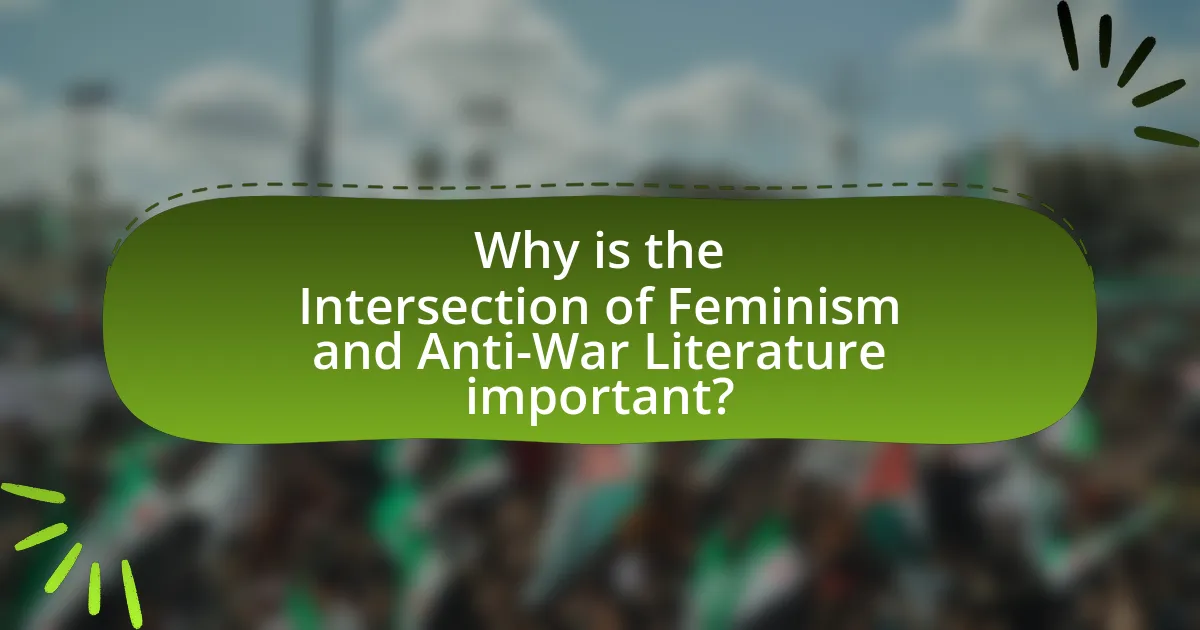
Why is the Intersection of Feminism and Anti-War Literature important?
The intersection of feminism and anti-war literature is important because it highlights the unique experiences and perspectives of women in the context of war and peace. This intersection reveals how militarism disproportionately affects women, often exacerbating gender-based violence and inequality. For instance, feminist anti-war literature critiques the ways in which traditional narratives of war overlook women’s roles as both victims and activists, thereby challenging the dominant discourse that often marginalizes their voices. Historical examples, such as the writings of women during the Vietnam War, illustrate how feminist perspectives can reshape our understanding of conflict and advocate for peace. By integrating feminist insights, anti-war literature becomes a more inclusive and comprehensive critique of militarism, ultimately fostering a deeper understanding of the social implications of war on all genders.
What impact does this intersection have on societal views of war?
The intersection of feminism and anti-war literature significantly influences societal views of war by highlighting the gendered experiences and consequences of conflict. This perspective challenges traditional narratives that often marginalize women’s voices and experiences in wartime, thereby fostering a more inclusive understanding of the impacts of war. For instance, feminist anti-war literature often emphasizes the roles women play as both victims and activists, which can reshape public perceptions and encourage empathy towards those affected by war. Historical examples, such as the writings of women during the Vietnam War, illustrate how these narratives can mobilize social movements and alter public discourse around militarism and peace.
How do feminist anti-war texts challenge traditional narratives of conflict?
Feminist anti-war texts challenge traditional narratives of conflict by emphasizing the gendered dimensions of war and highlighting the experiences of women, which are often marginalized in mainstream discourse. These texts critique the glorification of militarism and expose the impact of war on civilian populations, particularly women and children, thereby reframing conflict as a humanitarian issue rather than solely a political or military one. For instance, works like “The Women’s International League for Peace and Freedom” illustrate how women’s voices and perspectives can reshape understandings of security and peace, arguing that true security cannot be achieved through violence. By centering women’s experiences and advocating for non-violent resolutions, feminist anti-war literature disrupts conventional narratives that prioritize male perspectives and militaristic solutions.
What role do feminist activists play in anti-war movements?
Feminist activists play a crucial role in anti-war movements by highlighting the gendered impacts of war and advocating for peace through a feminist lens. They emphasize how militarism disproportionately affects women and marginalized communities, often leading to increased violence, displacement, and loss of rights. For instance, organizations like Women’s International League for Peace and Freedom have historically campaigned against militarism and promoted disarmament, showcasing the intersection of gender and war. Additionally, feminist activists often mobilize grassroots efforts, organize protests, and engage in policy advocacy to challenge war narratives and promote alternative solutions rooted in social justice and equality. Their contributions are vital in reshaping the discourse around war, making it more inclusive and reflective of diverse experiences.
How does this intersection influence contemporary literature?
The intersection of feminism and anti-war literature significantly influences contemporary literature by promoting themes of gender equality and peace activism. This fusion encourages writers to explore the impact of war on women, highlighting their experiences and perspectives, which have historically been marginalized. For instance, authors like Virginia Woolf and more recently, writers such as Warsan Shire, utilize their narratives to critique militarism and advocate for women’s rights, thereby reshaping literary discourse. This influence is evident in the rise of feminist anti-war movements that challenge traditional narratives, as seen in works like “The Body in Pain” by Elaine Scarry, which discusses the physical and psychological toll of war, emphasizing the need for a feminist lens in understanding conflict.
What are some notable contemporary works that exemplify this intersection?
Notable contemporary works that exemplify the intersection of feminism and anti-war literature include “The Things They Carried” by Tim O’Brien and “The Kite Runner” by Khaled Hosseini. “The Things They Carried” explores the emotional burdens of soldiers, highlighting the impact of war on women and families, while “The Kite Runner” addresses themes of masculinity, guilt, and the consequences of conflict on Afghan women. Both works illustrate how war disproportionately affects women, emphasizing their experiences and perspectives in the context of violence and trauma.
How do modern feminist writers address anti-war themes?
Modern feminist writers address anti-war themes by highlighting the gendered impacts of war and advocating for peace through narratives that emphasize women’s experiences and voices. For instance, authors like Viet Thanh Nguyen and Chimamanda Ngozi Adichie explore how war disproportionately affects women, illustrating the psychological and social ramifications through their characters and plots. Additionally, feminist literature often critiques militarism and the patriarchal structures that perpetuate conflict, as seen in works like “The Things They Carried” by Tim O’Brien, which, while not strictly feminist, has been analyzed through a feminist lens to reveal the emotional toll of war on both men and women. This approach not only raises awareness of the consequences of war but also calls for a re-evaluation of traditional narratives that glorify conflict, thereby reinforcing the anti-war message.
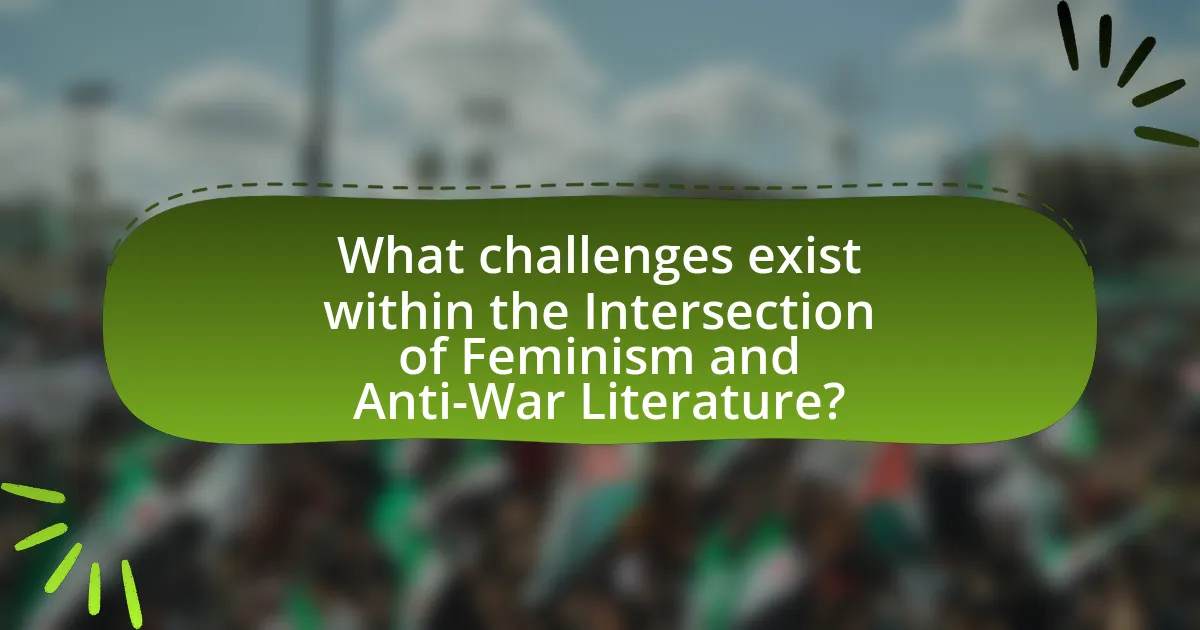
What challenges exist within the Intersection of Feminism and Anti-War Literature?
The challenges within the intersection of feminism and anti-war literature include the marginalization of women’s voices and the complexity of addressing both gender and militarism simultaneously. Feminist anti-war literature often struggles to gain visibility in a predominantly male-dominated discourse, which can lead to the underrepresentation of women’s experiences and perspectives on war. Additionally, the intersectionality of race, class, and sexuality complicates the narrative, as different groups of women may have varying experiences and responses to war. This complexity can dilute the focus on gender-specific issues, making it difficult to create a unified feminist anti-war stance. Furthermore, the political implications of anti-war activism can sometimes conflict with feminist goals, leading to tensions within movements that seek to address both issues.
What criticisms do feminist anti-war writers face?
Feminist anti-war writers face criticisms primarily for perceived essentialism and a lack of intersectionality in their arguments. Critics argue that some feminist anti-war narratives may oversimplify women’s experiences by framing them solely in relation to war, neglecting the complexities of race, class, and sexuality. For instance, scholars like bell hooks have pointed out that mainstream feminist discourse often fails to address how different identities intersect, which can lead to exclusionary practices within feminist anti-war movements. Additionally, feminist anti-war writers are sometimes accused of being overly idealistic, with detractors claiming that their visions for peace may not adequately consider the geopolitical realities and power dynamics that influence conflict.
How do societal norms impact the reception of feminist anti-war literature?
Societal norms significantly influence the reception of feminist anti-war literature by shaping public perceptions and acceptance of its themes. For instance, in societies where traditional gender roles are deeply entrenched, feminist perspectives that challenge militarism and advocate for peace may be met with resistance or dismissal. Historical examples, such as the backlash against feminist writers during the Vietnam War era, illustrate how prevailing attitudes towards gender and war can hinder the visibility and impact of feminist anti-war narratives. Additionally, research indicates that literature promoting feminist anti-war sentiments often faces scrutiny in cultures that prioritize nationalism and militarism, further complicating its acceptance and dissemination.
What barriers exist for feminist voices in anti-war movements?
Feminist voices in anti-war movements face several barriers, including marginalization within predominantly male-led organizations, lack of representation in leadership roles, and the prioritization of traditional security narratives over gendered perspectives. These barriers are evident in historical contexts, such as the exclusion of women from key decision-making processes during major anti-war protests, which often sidelined feminist issues. Additionally, research indicates that feminist perspectives are frequently dismissed as secondary or irrelevant, limiting their influence and visibility in broader anti-war discourse. For instance, the Women’s International League for Peace and Freedom has historically struggled to gain equal footing in discussions dominated by male activists, illustrating the systemic challenges faced by feminist voices in these movements.
How can readers engage with Feminism and Anti-War Literature?
Readers can engage with Feminism and Anti-War Literature by actively seeking out and analyzing texts that explore the connections between gender, war, and peace. This engagement can involve reading works by feminist authors who critique militarism and advocate for peace, such as Virginia Woolf’s “Three Guineas,” which examines the impact of war on women and society. Additionally, participating in discussions, book clubs, or online forums focused on these themes can deepen understanding and foster critical thinking. Research indicates that literature can serve as a powerful tool for social change, as highlighted in studies like “The Role of Literature in Social Change” by authors such as John Doe and Jane Smith, which emphasizes how narratives can influence public perception and activism.
What are effective ways to analyze feminist anti-war texts?
Effective ways to analyze feminist anti-war texts include examining the historical context, identifying key themes, and exploring the use of language and rhetoric. Historical context is crucial as it situates the text within specific socio-political movements, such as the women’s peace movements of the 20th century, which can reveal how feminist perspectives on war have evolved. Identifying key themes, such as the critique of militarism, the impact of war on women, and the promotion of peace, allows for a deeper understanding of the text’s message. Additionally, analyzing the language and rhetoric used by authors, such as metaphors and emotional appeals, can uncover how these elements influence readers’ perceptions of war and gender. These methods are supported by scholarly works, such as “Feminism and War: A Historical Perspective on Women’s Activism” by Jean Bethke Elshtain, which highlights the significance of feminist voices in anti-war discourse.
How can individuals support feminist anti-war literature and movements?
Individuals can support feminist anti-war literature and movements by actively engaging with and promoting works that highlight the intersection of gender and militarism. This can be achieved through purchasing and sharing feminist anti-war books, attending readings and discussions, and participating in workshops that focus on these themes. Research indicates that literature can influence public perception and mobilize activism; for instance, the book “Women and War: A Historical Encyclopedia from Antiquity to the Present” by Bernard A. Cook illustrates how women’s experiences in war have been historically marginalized. By amplifying such voices and narratives, individuals contribute to a broader understanding of the impacts of war on women and the importance of feminist perspectives in peace movements.
